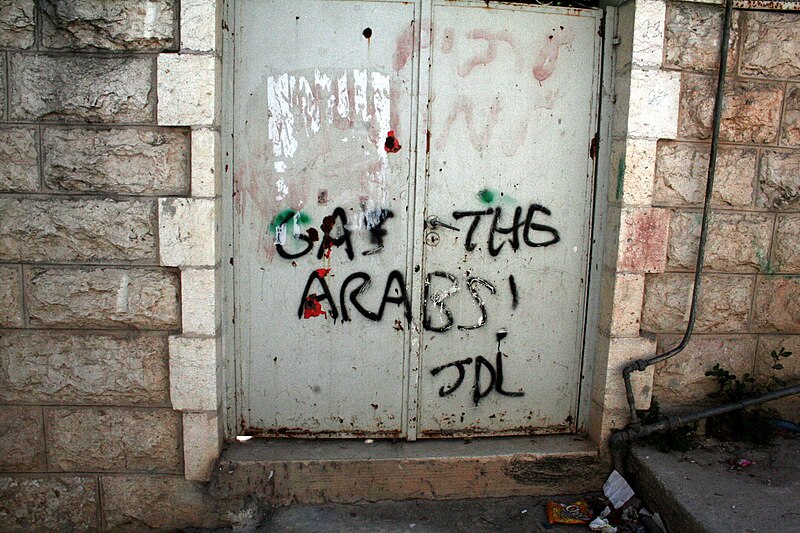
"Gas the Arabs" painted on the gate outside a Palestinian home in Hebron by Israeli settlers. It is signed "JDL" (Jewish Defence League): photo by Magne Hagesaeter, 29 June 2008
To protect these settlers, the zone bristles with barriers, camps and military posts, and is overrun by Israeli patrols. But such mobilisation will soon be unnecessary because this part of Hebron, subject to ethnic and religious cleansing, will soon have no Arab residents.
Its centuries-old market, which was once as multi-coloured, varied and bustling as that of Jerusalem, is now empty and the doors of all the shops are sealed. Travelling around, you feel in limbo. So too when you walk through the surrounding deserted streets, with shopfronts shuttered with metal sheets and on whose roofs you glimpse military posts. The walls of this entire semi-empty neighbourhood are filled with racist inscriptions: "Death to the Arabs".
Some 25,000 residents have been cleared from their homes in H-2 zone in five years. In the Tel Rumeida neighbourhood alone, where there is a settlement of the same name, barely 50 out of 500 Arab families remain.
The extraordinary thing is that they haven't already gone, subjected as they are to systematic and ferocious harassment by settlers, who stone them, throw rubbish and excrement at their houses, invade and destroy their homes, and attack their children when they return from school, to the absolute indifference of Israeli soldiers who witness these atrocities.
No one told me this: I saw it with my own eyes and heard with my own ears from the victims themselves. I have a video of the hair-raising scene of children from Tel Rumeida settlement stoning and kicking Arab schoolchildren and their teachers who, to protect themselves, returned home in groups instead of individually. When I told Israeli friends this, some looked at me with incredulity and I saw they suspected I exaggerated or lied, as novelists often do. It turned out that none had ever set foot in Hebron.
Mario Vargas Llosa: extract from the chapter El horror se llama Hebrón (The horror that is called Hebron), in Israel / Palestina: Paz o guerra santa (Israel / Palestine: peace or holy war), El País, 5 October 2005; abridged and translated by Elizabeth Nash as How the Arabs have been driven out of Hebron, The Independent, 23 October 2011
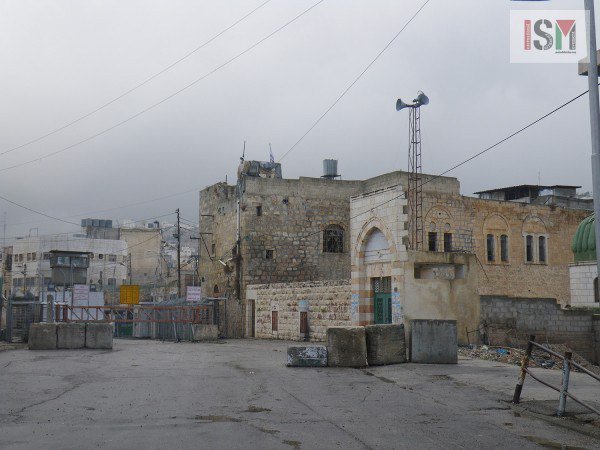
#IsraeliForces continue to arbitrarily declare ‘closed military zones’
around #Hebron: image via ISM Palestine @ISMPalestine, 10 November 2015
El horror se llama Hebrón (from Israel / Palestina: Paz o guerra santa): Mario Vargas Llosa, El País, 5 October 2005
Hebrón, ciudad palestina de unos 130.000 habitantes árabes y 500 colonos judíos, está sólo a 36 kilómetros de Jerusalén, pero llegar a ella es una aventura de contornos kafkianos, que puede durar muchas horas. El mapa indica que hay varias entradas posibles a Hebrón, pero, en la realidad, muchas de esas entradas están clausuradas con grandes piedras o altos de basura o con barreras militares, en las que, como en el juego infantil de "el paraíso" ("¿Es aquí el paraíso?". "No, en la otra esquina") los soldados de guardia, muy amables, despachan al automovilista a otro checkpoint diez o veinte kilómetros más allá que, por supuesto, resulta también cerrado. Después de un par de horas de este juego deprimente optamos por intentar algo que parecía improbable: llegar a la ciudad cruzando por el asentamiento de Kiryat Arba.
Los asentamientos son el meollo del problema palestino-israelí.
Es para proteger a estos colonos que toda la zona está erizada de barreras, campamentos y puestos militares y recorrida por patrullas israelíes. Pero, tal como van las cosas, esa movilización será dentro de poco bastante innecesaria porque ese sector de Hebrón, donde se lleva a cabo una sistemática limpieza étnica o religiosa, quedará sin vecinos árabes. Su mercado es varias veces centenario y, al parecer, cuando las tiendas estaban abiertas y acudían compradores era tan multicolor, variado y atestado como el de Jerusalén. Ahora está vacío y con las puertas de todos los comercios selladas.
Recorriéndolo, uno se siente en el limbo. Y también cuando camina por las desiertas calles de los contornos, con todas las fachadas clausuradas con placas metálicas y en cuyos techos se divisan de tanto en tanto puestos militares. Las paredes de todo este barrio semivacío están llenas de inscripciones racistas "Muerte a los árabes" y también de insultos y amenazas a Sharon, por la desactivación de Gaza. Frente al cementerio hay una inscripción homicida: "Sharon: Rabin te espera aquí".
El periodista Gideon Levy, del diario Haaretz -- un magnífico periodista y un excelente diario, por lo demás -- a quien conocí mientras recorría Hebrón, señala en un artículo del 11 de septiembre que en los últimos cinco años unos 25.000 residentes han sido erradicados de sus hogares en la zona H-2 de la ciudad. Y sólo en el barrio de Tel Rumeida, donde está el asentamiento de este nombre, de las 500 familias árabes que allí residían quedan apenas 50. Lo extraordinario es que éstas no se hayan marchado todavía, sometidas como están a un acoso sistemático y feroz de parte de los colonos, que las apedrean, arrojan basuras y excrementos a sus casas, montan expediciones para invadir sus viviendas y destrozarlas, y atacan a sus niños cuando regresan de la escuela, ante la absoluta indiferencia de los soldados israelíes que presencian estas atrocidades. Nadie me lo ha contado: yo lo he visto con mis propios ojos y lo he oído con mis propios oídos de boca de las mismas víctimas. Y tengo en mi poder un vídeo donde se ve la espeluznante escena de niños y niñas del asentamiento de Tel Rumeida apedreando y pateando a los escolares árabes y sus maestras de la escuela "Córdoba" (Qurtaba), del barrio, quienes, para protegerse unos a otros, regresan a sus hogares en grupo en vez de hacerlo de manera individual. Cuando comenté esto con amigos israelíes, algunos me miraron con incredulidad y vi en sus ojos la sospecha de que yo exageraba o mentía, como suelen hacer los novelistas. Ocurre que ninguno de ellos pisa jamás Hebrón ni tampoco lee a Gideon Levy, a quien consideran el típico judío "judeófobo y antisemita".
Graffiti
such as "Die Arab Sand-Niggers!" is often sprayed on Palestinian houses
by Israeli settlers, Hebron, West Bank, Palestine: photo by Christian Peacemaker Teams, 3 May 2002
Baruch
Goldstein, b. 1956 Brooklyn, New York, Israeli terrorist settler and
perpetrator of the 1994 Cave of the Patriarchs massacre in the city of Hebron, killing 29 Muslim worshippers and wounding another 125: photo via Falafel Cafe, 2 March 2010
Tombstone of Baruch Goldstein, Meir Kahane Tourist Park, Kiryat Arba, Palestinian Occupied Territories
Gravestone text (very rough translation; Hebrew Jewish acronyms are translated with dashes separating the words):
Here-is-buried
The Holy
The physician Mr. Barukh Kappel Goldstein
Blessed-be-the-memory-of-
Son of Mr. Israel, who, in contrast is still alive, and should continue to a long and good life, Amen Seventh generation of Rebbe The Old "Master of the Tanya"
Rabbi Shneur Zalman of Liadi
Gave his life for the nation of Israel, its Torah and its land
"Clean of hands and pure of heart"
Born 5th of Tevet, 5717
Murdered over making the Lord holy
14th of Adar, Purim 5754
May-his-soul-be-listed-among-t
photo by Itai, 12 June 2009

IDF soldier patrolling in Hebron old city: photo by Christian Peacemaker Teams, 6 October 2012
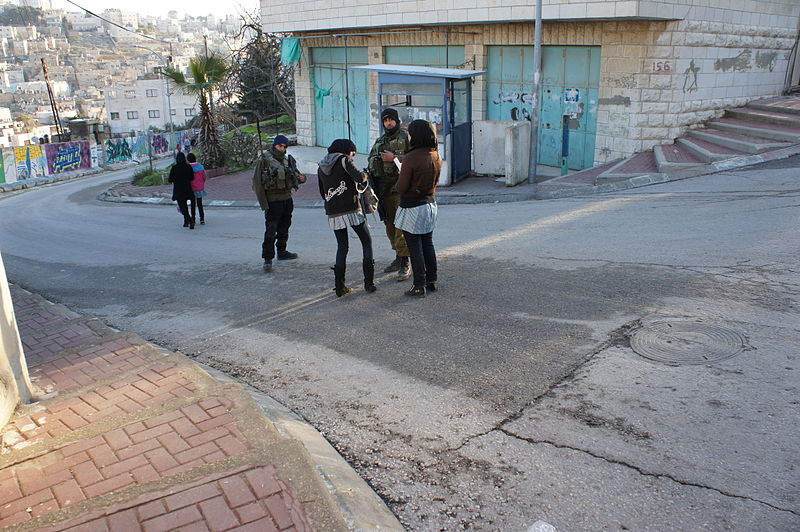
Golani soldiers checking school-girls in Tel Rumeida, by Gilbert checkpoint: photo by Friends123, 16 January 2012

Golani soldiers searching a Palestinian in Tel Rumeida, by Gilbert checkpoint. Palestinians are routinely searched or detained.: photo by Friends123, 16 January 2012

Golani soldiers searching Palestinians in Tel Rumeida, by Gilbert checkpoint. Palestinians are routinely searched or detained.: photo by Friends123, 22 January 2012
Palestinian men detained at a checkpoint in the old city: photo by Justin McIntosh, August 2004

Jewish settler tour of the old city in Hebron. This takes place every Saturday, with massive military escort. All other activity in the old city must stop until the settlers have passed.: photo by Friends123, 21 January 2012
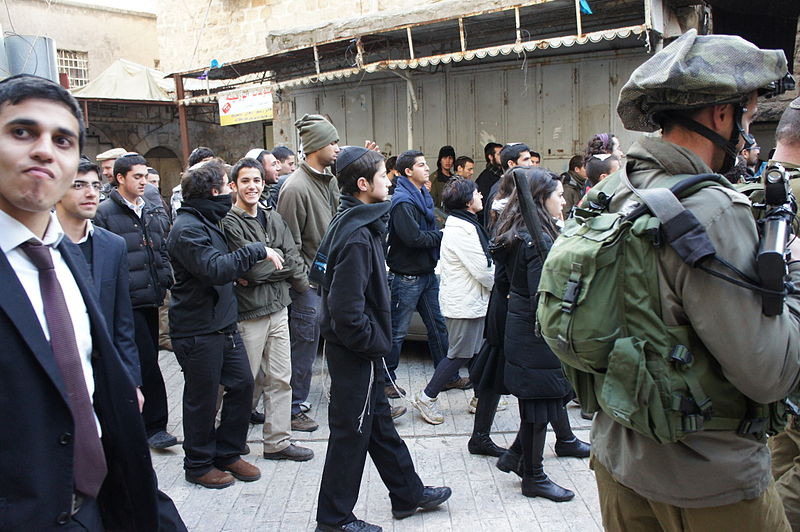
Jewish settler tour of the old city in Hebron. This takes place every Saturday, with massive military escort. All other activity in the old city must stop until the settlers have passed.: photo by Friends123, 21 January 2012
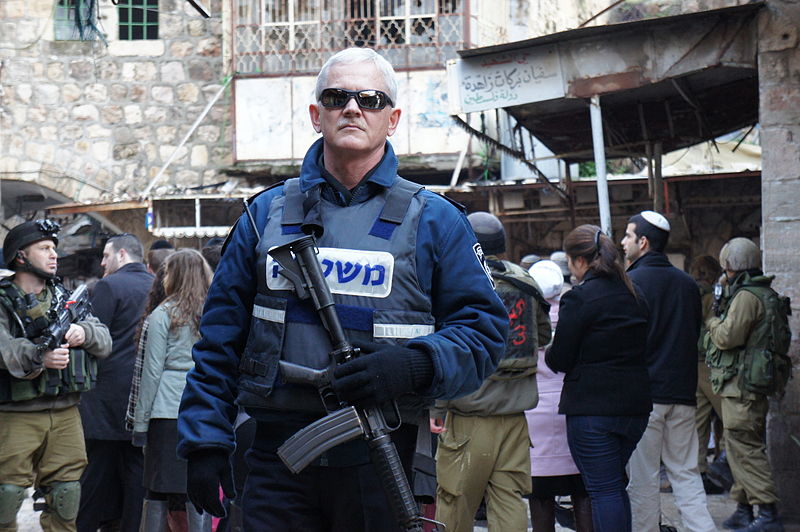
Jewish settler tour of the old city in Hebron. This takes place every Saturday, with massive military escort. All other activity in the old city must stop until the settlers have passed.: photo by Friends123, 21 January 2012
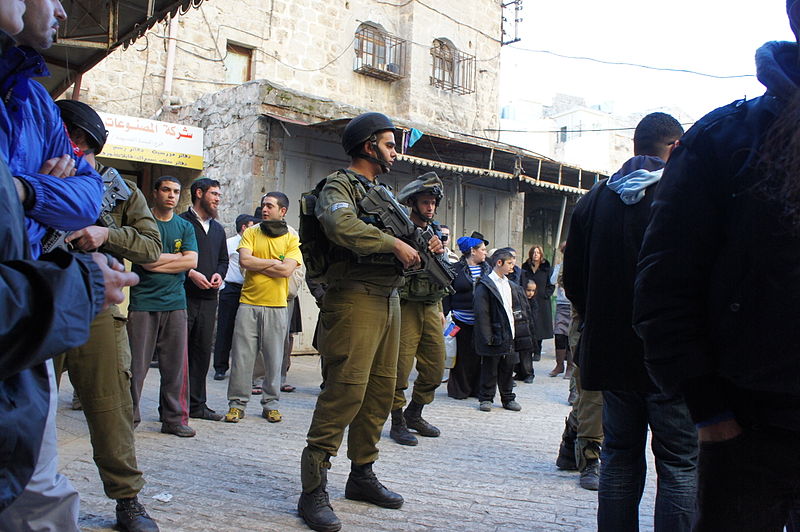
Jewish settler tour of the old city in Hebron. This takes place every Saturday, with massive military escort. All other activity in the old city must stop until the settlers have passed.: photo by Friends123, 4 February 2012

Soldiers detaining children in Hebron: photo by Friends123, 4 February 2012

Soldiers detaining children in Hebron: photo by Friends123, 4 February 2012
Abandoned shops in Hebron old city: photo by Justin McIntosh, August 2004
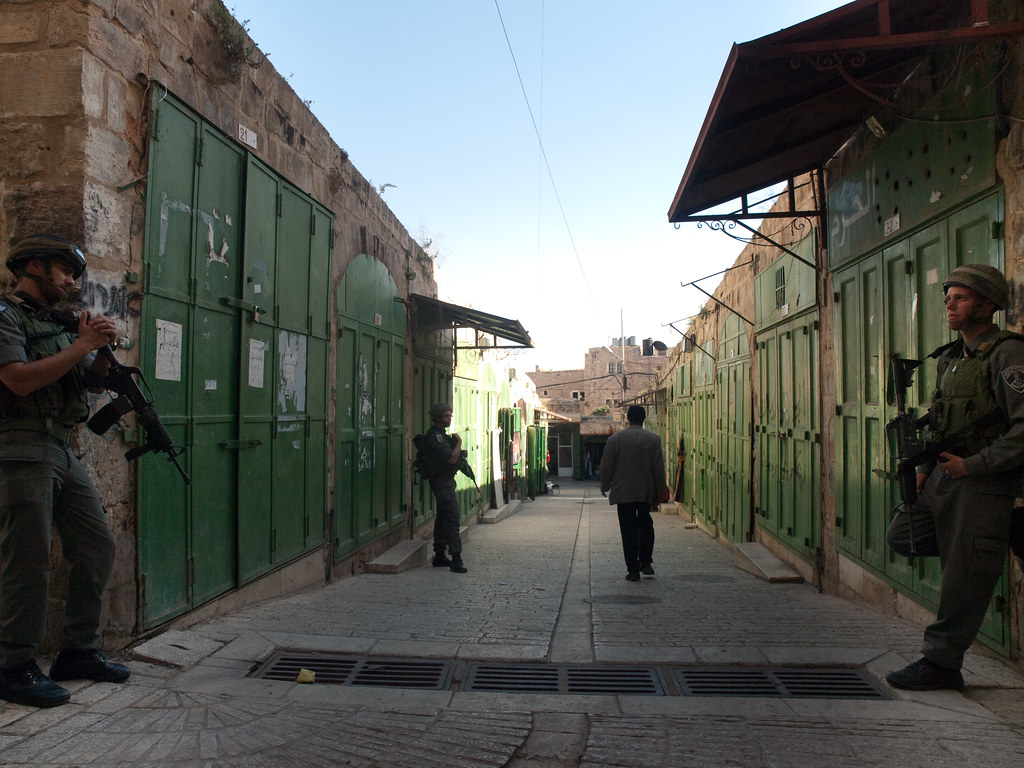
Street with closed Palestinian shops in the Old City of Hebron, guarded by Israeli soldiers: photo by Palestinian Festival of Literature, 5 May 2010
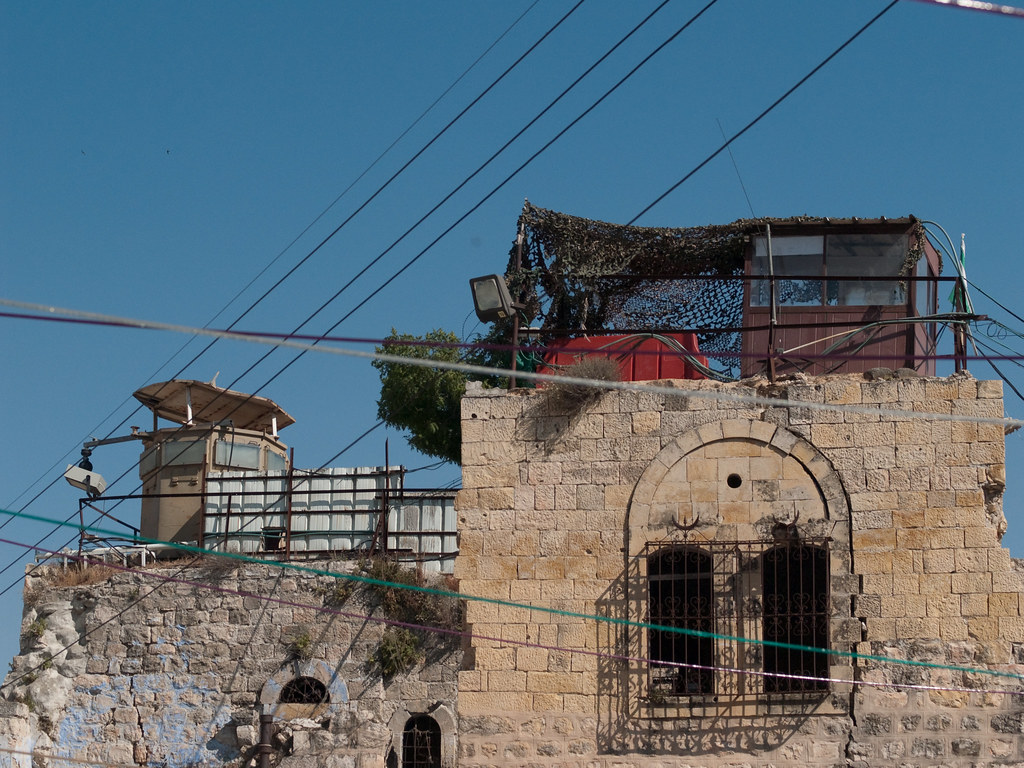
A watchtower stands above a square in al Khalil/Hebron: photo by Palestinian Festival of Literature, 6 May 2010
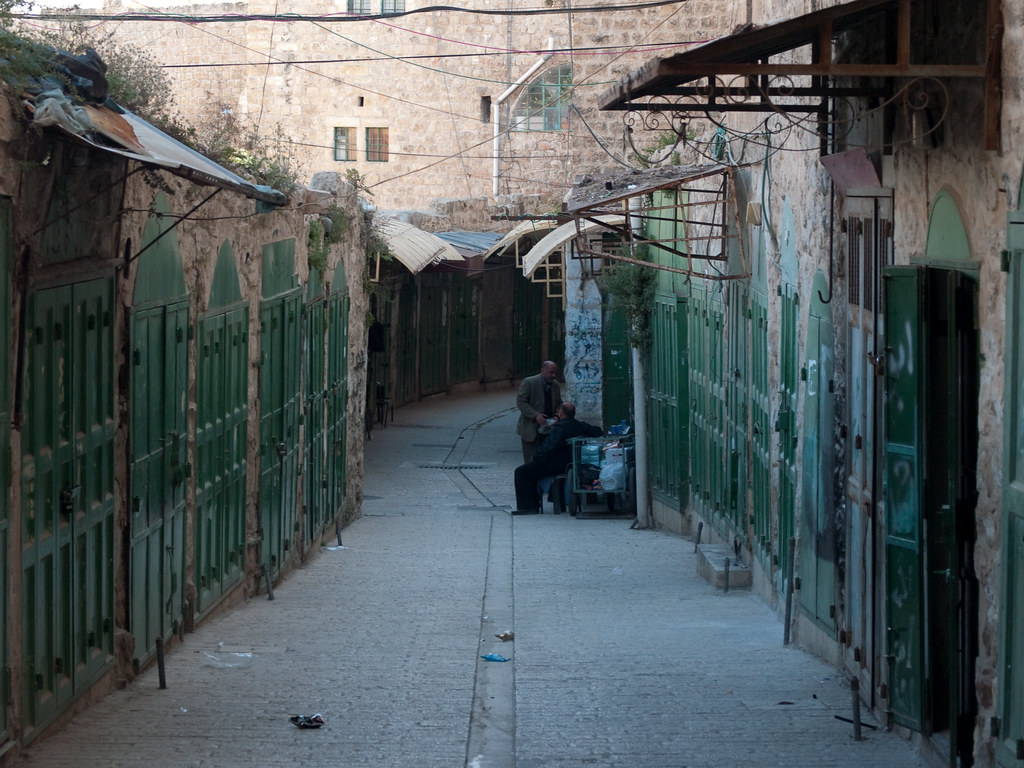
Deserted streets in Hebron old city: photo by Palestinian Festival of Literature, 6 May 2010
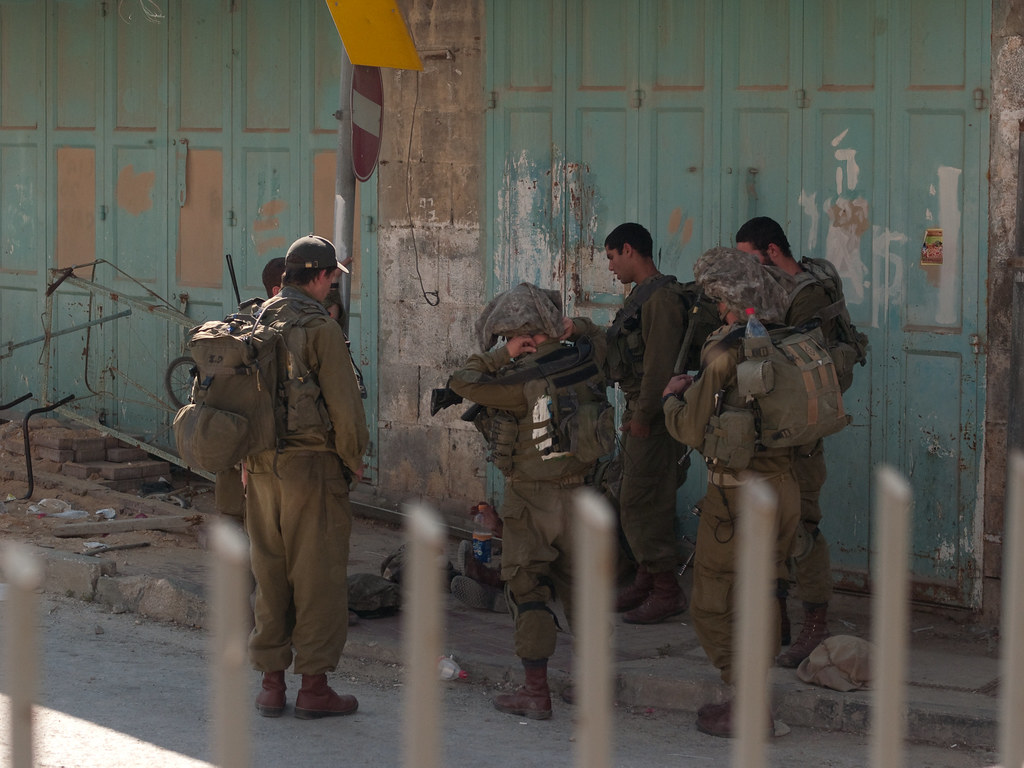
Soldiers in the old city of Hebron: photo by Palestinian Festival of Literature, 6 May 2010
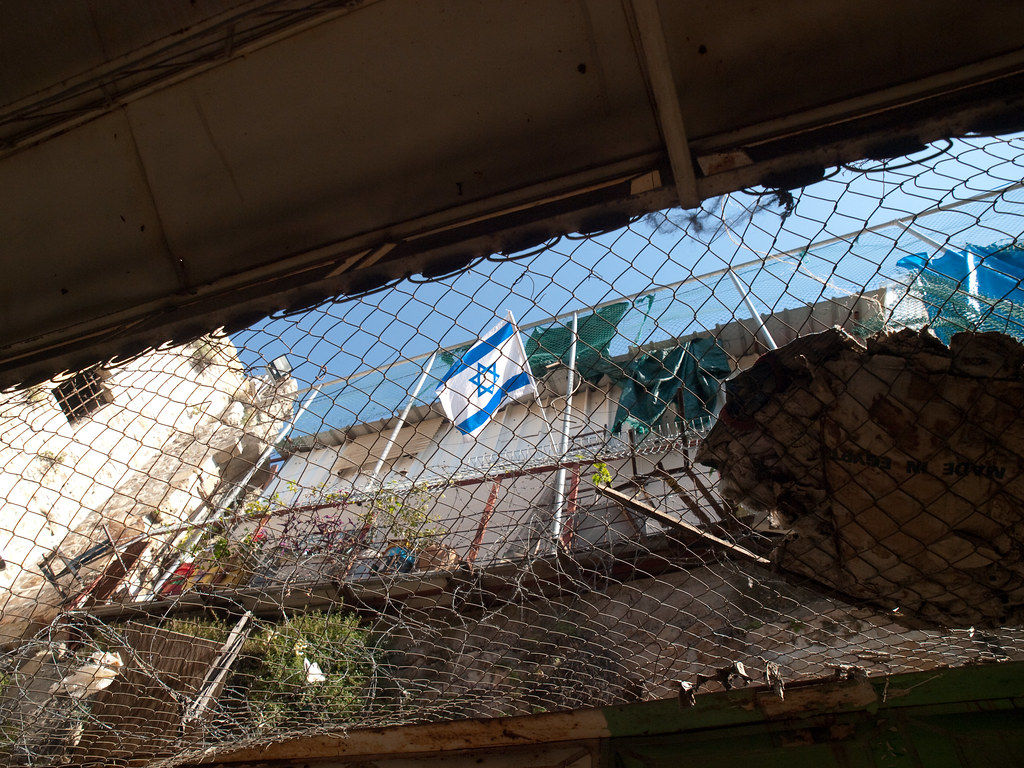
Rubbish, urine -- even acid -- is regularly thrown down on Palestinians from settlers living above: photo by Palestinian Festival of Literature, 5 May 2010
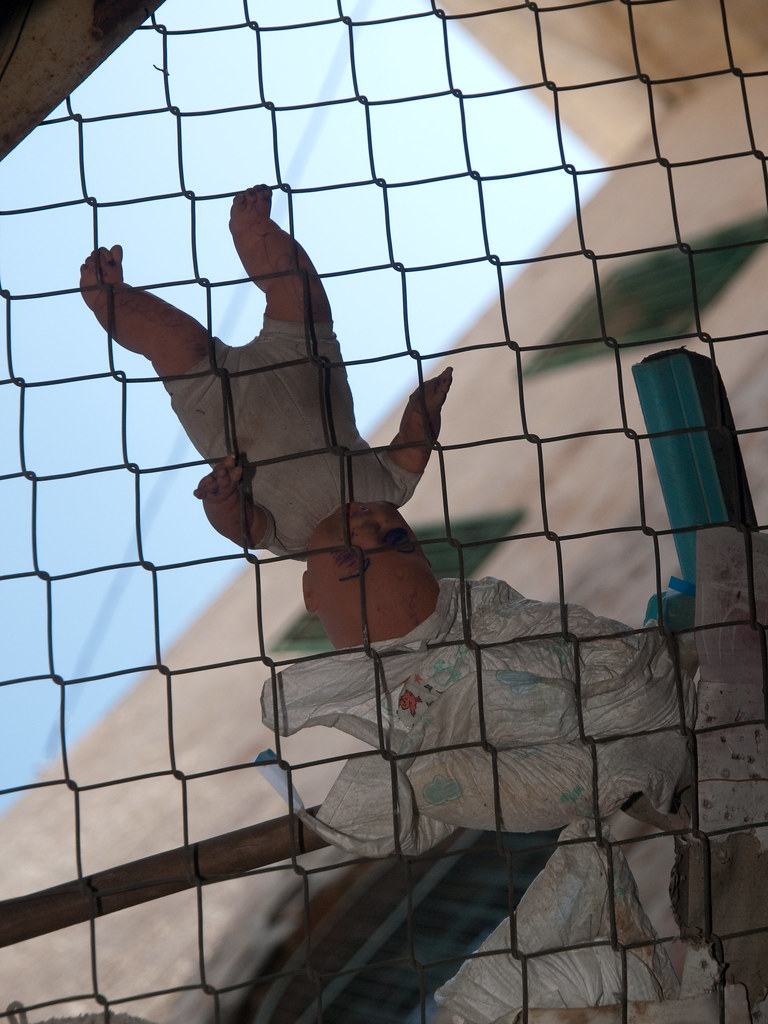
Rubbish, urine -- even acid -- is regularly thrown down on Palestinians from settlers living above: photo by Palestinian Festival of Literature, 5 May 2010
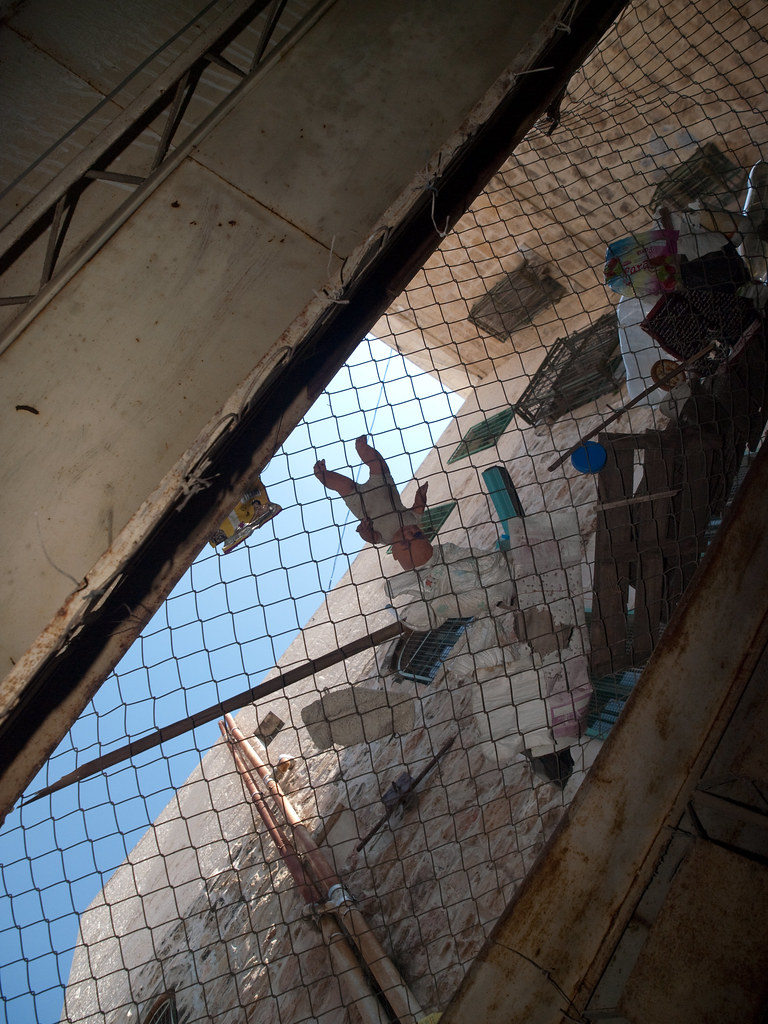
Rubbish, urine -- even acid -- is regularly thrown down on Palestinians from settlers living above: photo by Palestinian Festival of Literature, 5 May 2010
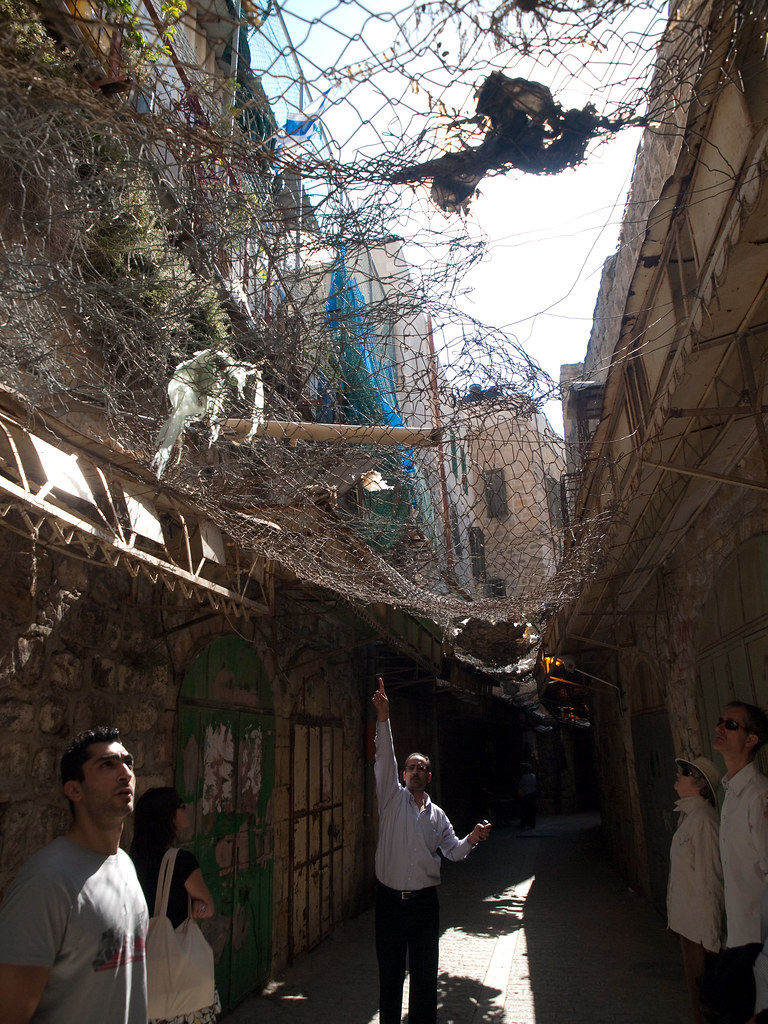
Rubbish, urine -- even acid -- is regularly thrown down on Palestinians from settlers living above: photo by Palestinian Festival of Literature, 5 May 2010
Sandbag placed to avoid raising of wires. Wires were raised to prevent objects thrown from apartment building occupied by Israeli Jews.: photo by Justin McIntosh, August 2004
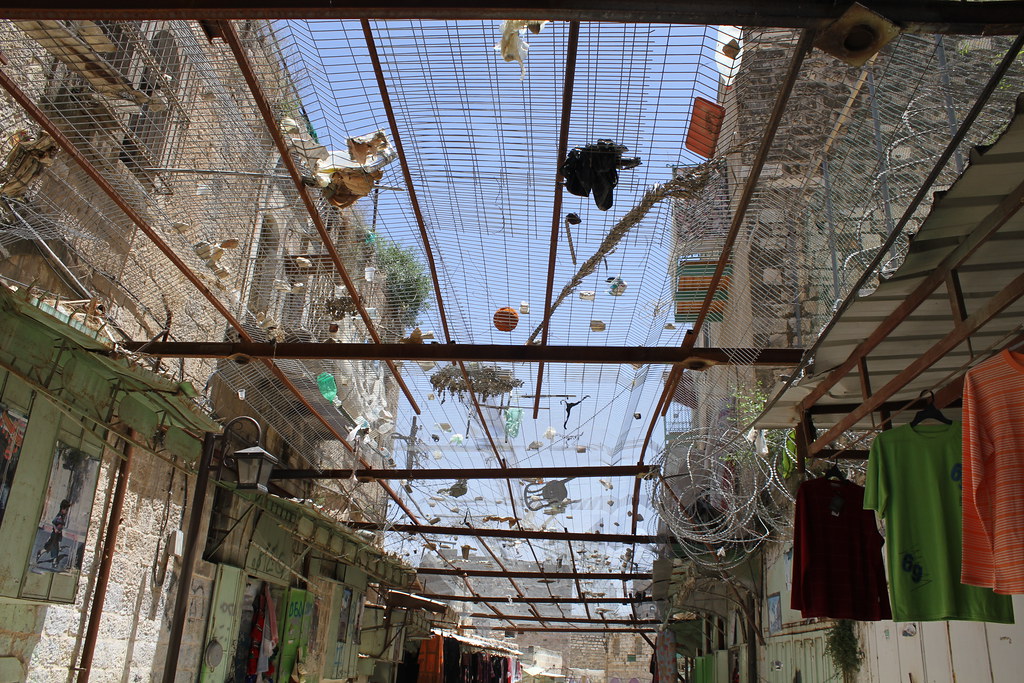
Wire ceilings have been put up over the market to protect Palestinians from rubbish thrown on them by settlers living in the colonized houses above: photo by Palestinian Festival of Literature, 15 May 2010
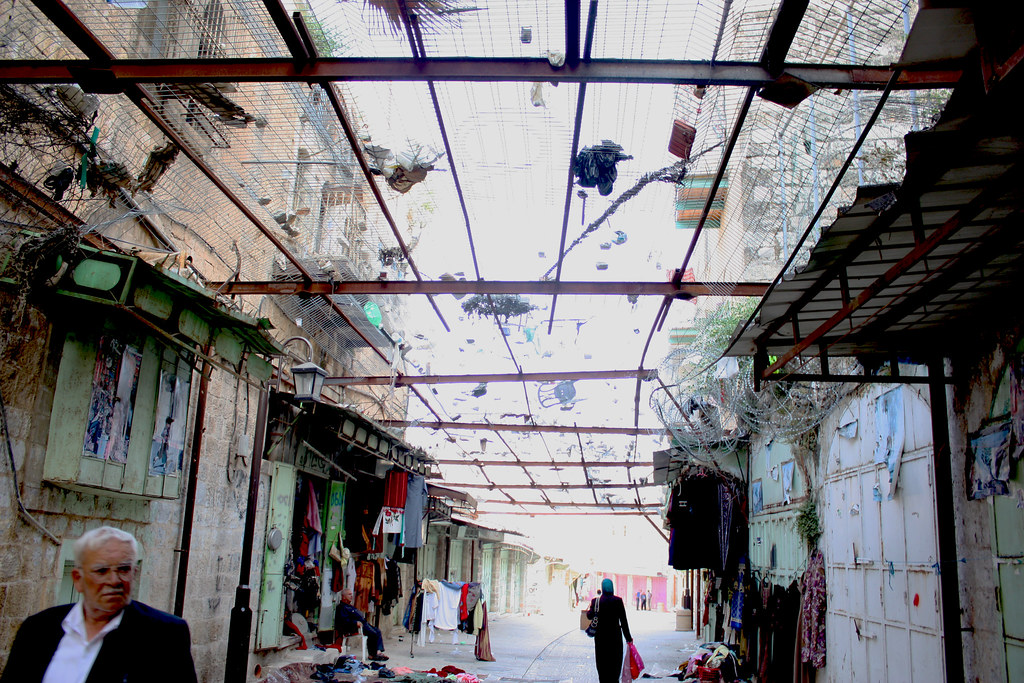
A net is put up in the old city of Hebron to separate the Palestinian and settler part. As you can see, the net is full of garbage which settlers have thrown down from their settlements on the second floor.: photo by ISM Palestine, 13 June 2010
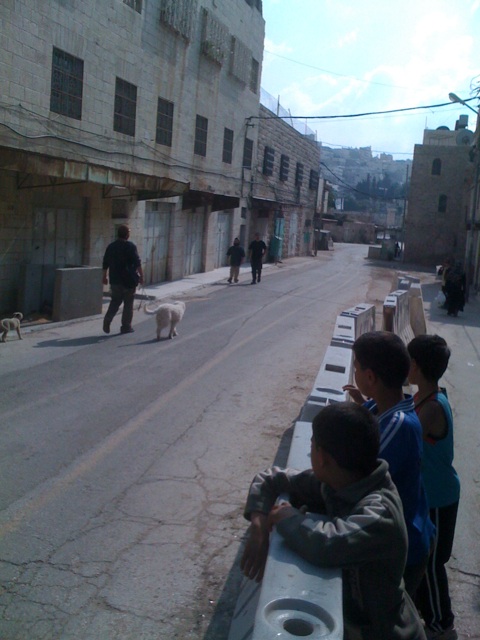
Shuhada Street in Hebron with closed Palestinian shops. Forbidden for Palestinians. Only Israeli settlers and tourists are allowed: photo by Palestinian Festival of Literature, 28 July 2009
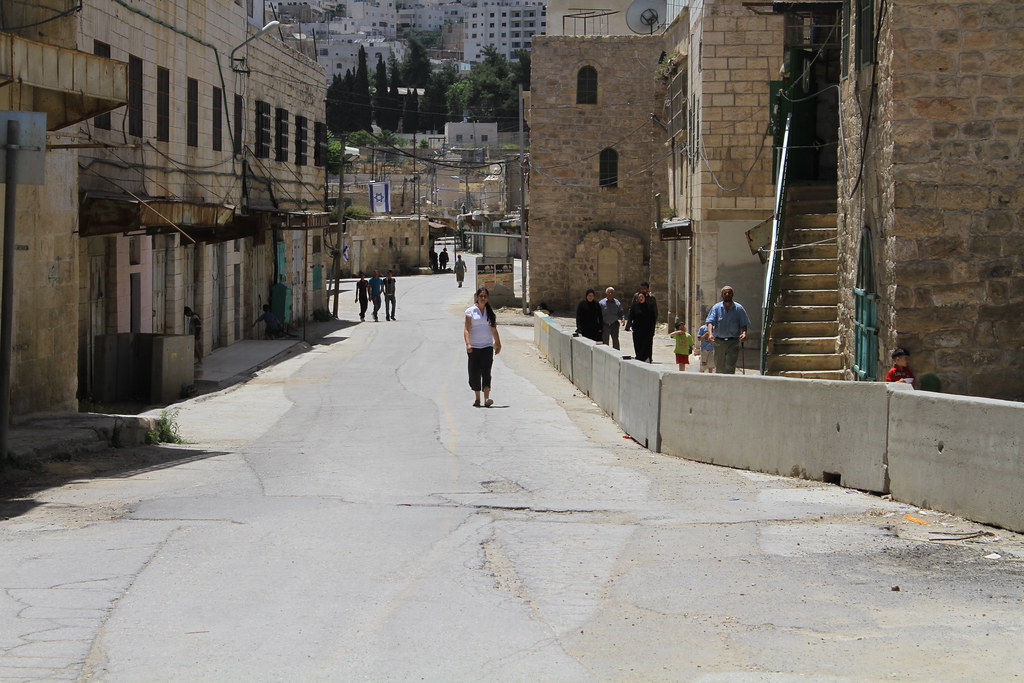
Shuhada Street apartheid. Shuhada Street in Hebron with closed Palestinian shops. Forbidden for Palestinians. Only Israeli settlers and tourists are allowed: photo by Palestinian Festival of Literature, 15 May 2010
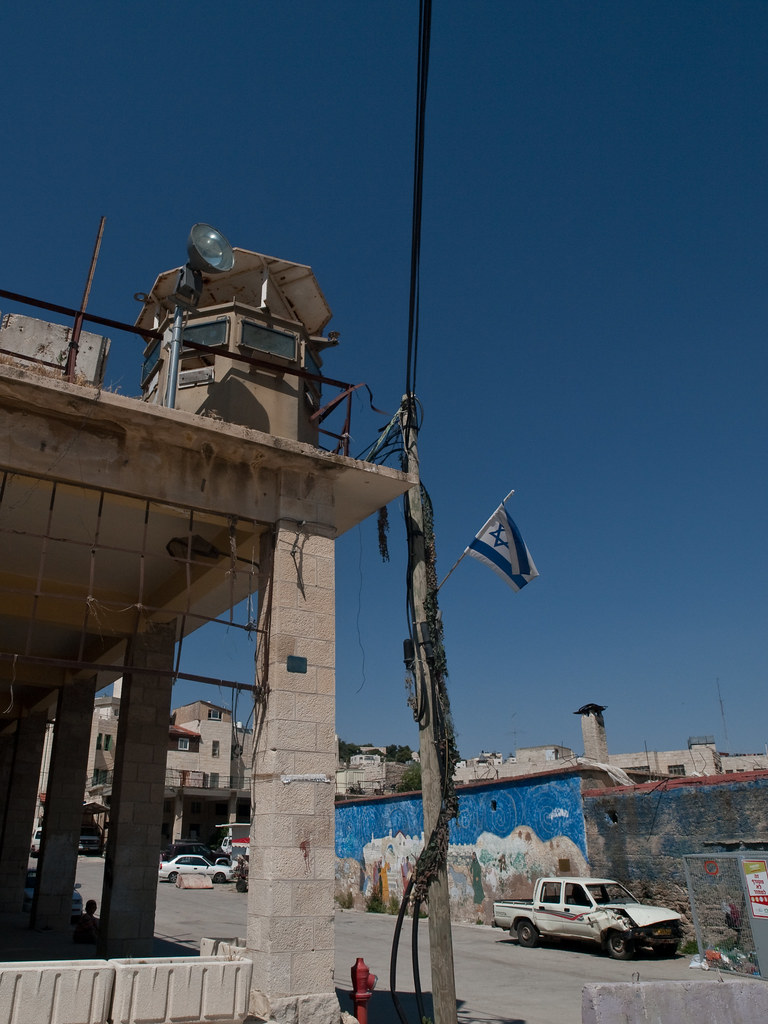
A watchtower stands over the ruined vegetable market: photo by Palestinian Festival of Literature, 5 May 2010
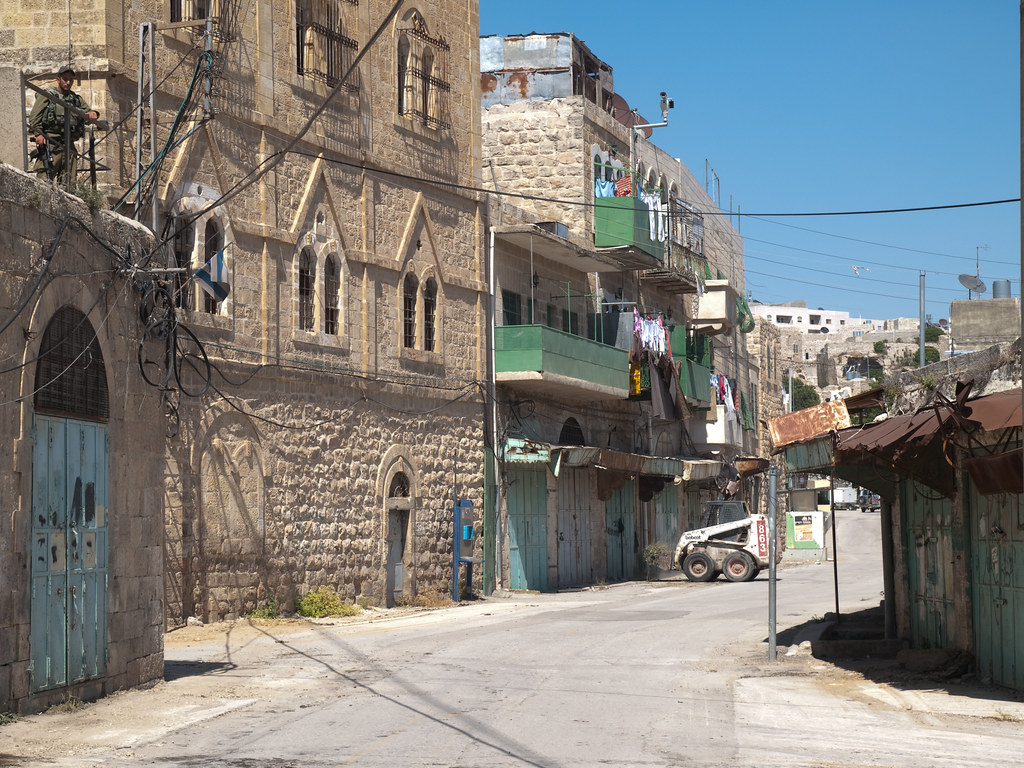
Shuhada street -- once the commercial spine of the city. Now all the shops have been forced to close: photo by Palestinian Festival of Literature, 5 May 2010

Roads cemented off by the military: photo by Palestinian Festival of Literature, 15 May 2010
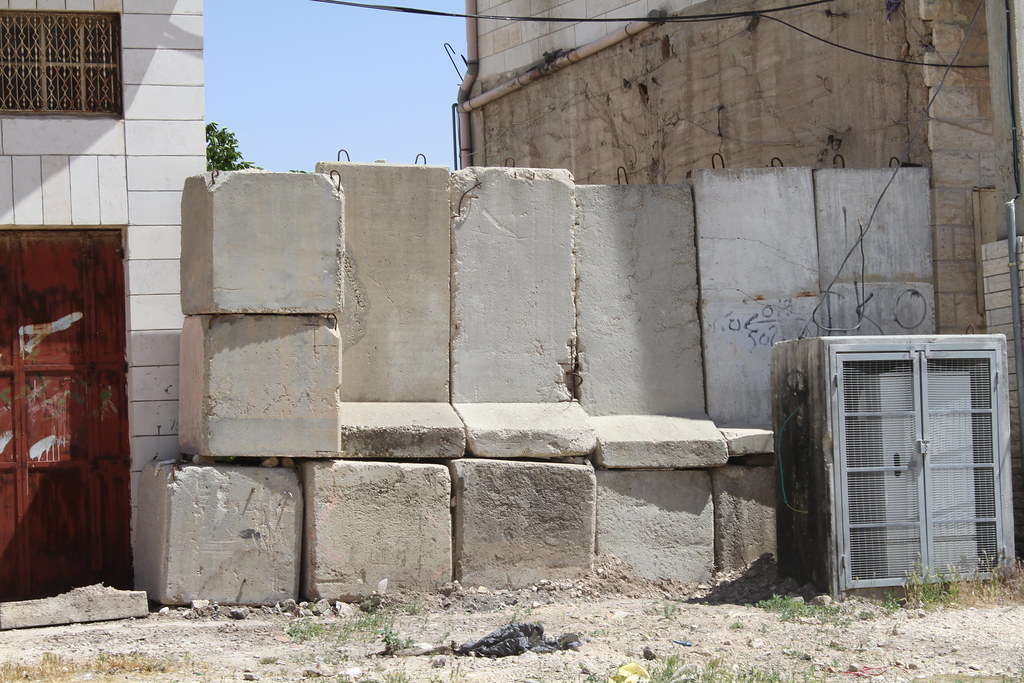
Cement blocks close off several roads in the old city: photo by Palestinian Festival of Literature, 15 May 2010
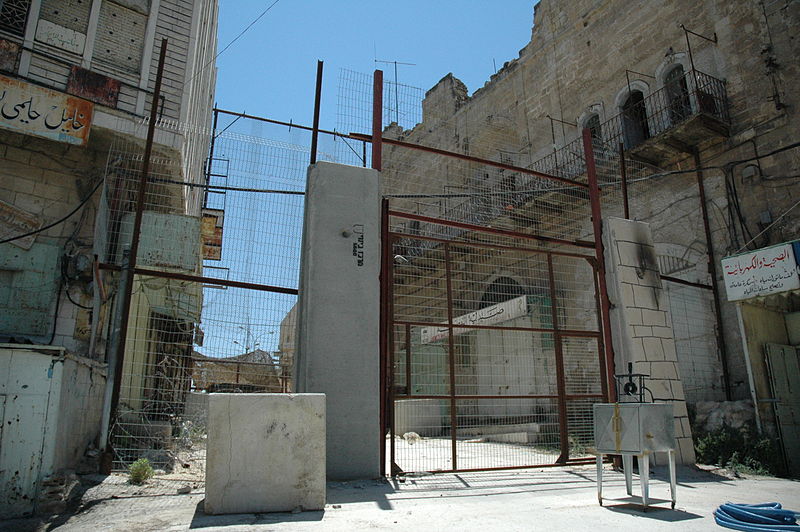
Road barrier on Palestinian street: photo by Justin McIntosh, August 2004

Palestinians car are denied access on road leading to the Kiryat Arba [settlement], even if it is in the Palestinian neighborhood of Wadi Al-Husain, in Hebron: photo by Stella via ISM Palestine, 31 October 2010
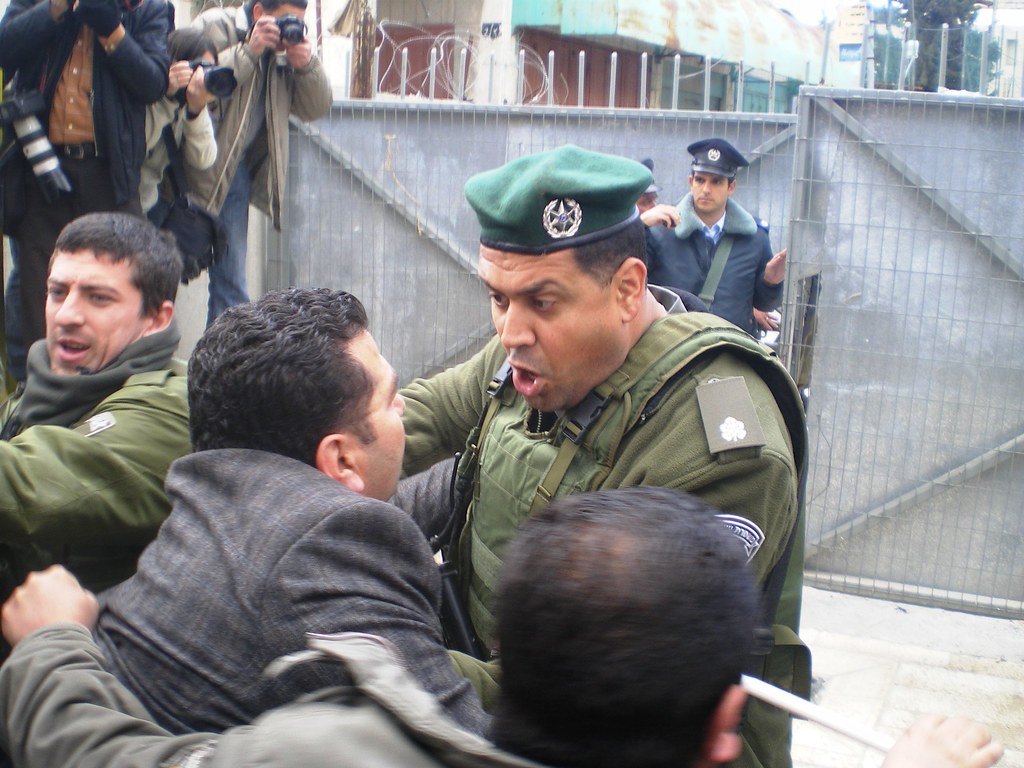
11:30am on Saturday, the 28th of March, Israeli forces violently dispersed a Hebron demonstration, firing tear gas and sound bombs and arresting one German solidarity activist: photo by ISM Palestine, 28 March 2007
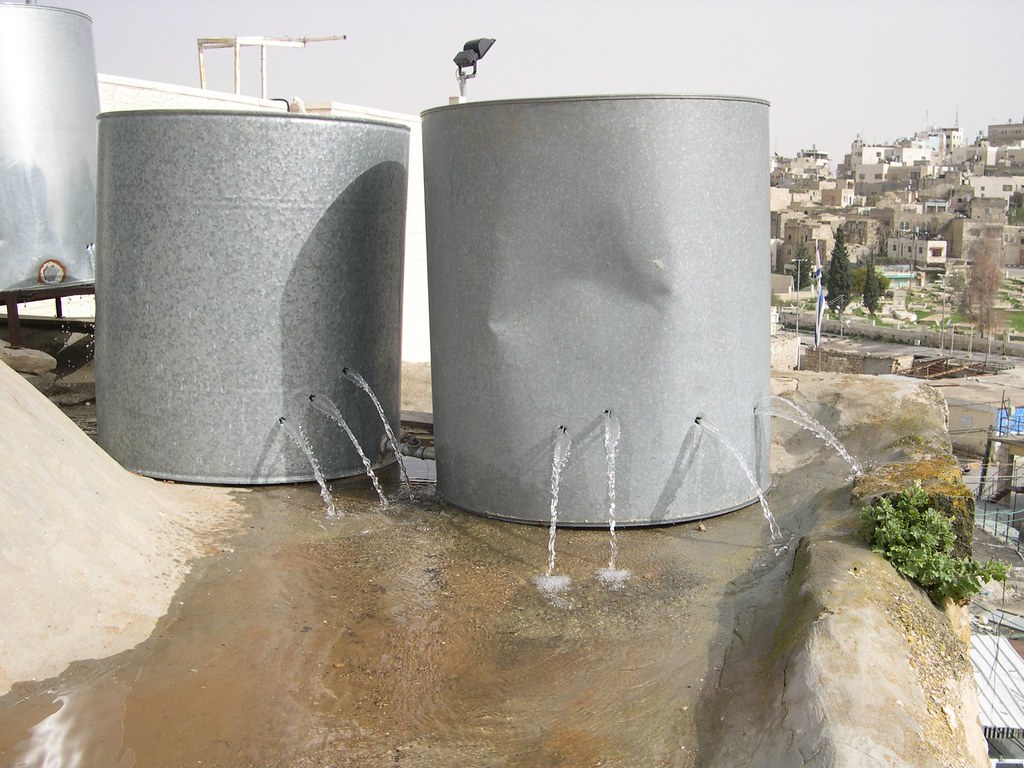
Palestinian water tanks destroyed by settlers in Hebron. At about 3 PM the 14th of April in the old city of Hebron, 5 Israeli settlers trespassed onto the roof of a Palestinian house, puncturing the 5 water tanks owned by the family and draining all of their water supply, in addition the settlers smashed the cage of the family's doves and the doves escaped. One of the 5 settlers was armed and he went down the stairs from the the rooftop and smashed a potted plant and threatened the father of the family with his weapon.: photo by ISM Palestine, 15 April 2009
The Holy
The physician Mr. Barukh Kappel Goldstein
Blessed-be-the-memory-of-
Son of Mr. Israel, who, in contrast is still alive, and should continue to a long and good life, Amen Seventh generation of Rebbe The Old "Master of the Tanya"
Rabbi Shneur Zalman of Liadi
Gave his life for the nation of Israel, its Torah and its land
"Clean of hands and pure of heart"
Born 5th of Tevet, 5717
Murdered over making the Lord holy
14th of Adar, Purim 5754
May-his-soul-be-listed-among-t
photo by Itai, 12 June 2009
Graffiti of the Kach Party logo, taken by me in Hebron.
An Israeli friend of mine told me that the word for Kach below the logo
is spelt in an irregular way to make it look like the Hebrew word for
"force" or "violence" -- a sort of double meaning.: photo by Asa Winstanley, 20 July 2008
IDF break shop in Hebron: photo محمد الفلسطيني08 October 2015
Hebron: photo by eman, 28 March 2007

IDF soldier patrolling in Hebron old city: photo by Christian Peacemaker Teams, 6 October 2012

Golani soldiers checking school-girls in Tel Rumeida, by Gilbert checkpoint: photo by Friends123, 16 January 2012

Golani soldiers searching a Palestinian in Tel Rumeida, by Gilbert checkpoint. Palestinians are routinely searched or detained.: photo by Friends123, 16 January 2012

Golani soldiers searching Palestinians in Tel Rumeida, by Gilbert checkpoint. Palestinians are routinely searched or detained.: photo by Friends123, 22 January 2012
Palestinian men detained at a checkpoint in the old city: photo by Justin McIntosh, August 2004

Jewish settler tour of the old city in Hebron. This takes place every Saturday, with massive military escort. All other activity in the old city must stop until the settlers have passed.: photo by Friends123, 21 January 2012

Jewish settler tour of the old city in Hebron. This takes place every Saturday, with massive military escort. All other activity in the old city must stop until the settlers have passed.: photo by Friends123, 21 January 2012

Jewish settler tour of the old city in Hebron. This takes place every Saturday, with massive military escort. All other activity in the old city must stop until the settlers have passed.: photo by Friends123, 21 January 2012

Jewish settler tour of the old city in Hebron. This takes place every Saturday, with massive military escort. All other activity in the old city must stop until the settlers have passed.: photo by Friends123, 4 February 2012

Soldiers detaining children in Hebron: photo by Friends123, 4 February 2012

Soldiers detaining children in Hebron: photo by Friends123, 4 February 2012
Abandoned shops in Hebron old city: photo by Justin McIntosh, August 2004

Street with closed Palestinian shops in the Old City of Hebron, guarded by Israeli soldiers: photo by Palestinian Festival of Literature, 5 May 2010

A watchtower stands above a square in al Khalil/Hebron: photo by Palestinian Festival of Literature, 6 May 2010

Deserted streets in Hebron old city: photo by Palestinian Festival of Literature, 6 May 2010

Soldiers in the old city of Hebron: photo by Palestinian Festival of Literature, 6 May 2010

Rubbish, urine -- even acid -- is regularly thrown down on Palestinians from settlers living above: photo by Palestinian Festival of Literature, 5 May 2010

Rubbish, urine -- even acid -- is regularly thrown down on Palestinians from settlers living above: photo by Palestinian Festival of Literature, 5 May 2010

Rubbish, urine -- even acid -- is regularly thrown down on Palestinians from settlers living above: photo by Palestinian Festival of Literature, 5 May 2010

Rubbish, urine -- even acid -- is regularly thrown down on Palestinians from settlers living above: photo by Palestinian Festival of Literature, 5 May 2010
Sandbag placed to avoid raising of wires. Wires were raised to prevent objects thrown from apartment building occupied by Israeli Jews.: photo by Justin McIntosh, August 2004

Wire ceilings have been put up over the market to protect Palestinians from rubbish thrown on them by settlers living in the colonized houses above: photo by Palestinian Festival of Literature, 15 May 2010

A net is put up in the old city of Hebron to separate the Palestinian and settler part. As you can see, the net is full of garbage which settlers have thrown down from their settlements on the second floor.: photo by ISM Palestine, 13 June 2010

Shuhada Street in Hebron with closed Palestinian shops. Forbidden for Palestinians. Only Israeli settlers and tourists are allowed: photo by Palestinian Festival of Literature, 28 July 2009

Shuhada Street apartheid. Shuhada Street in Hebron with closed Palestinian shops. Forbidden for Palestinians. Only Israeli settlers and tourists are allowed: photo by Palestinian Festival of Literature, 15 May 2010

A watchtower stands over the ruined vegetable market: photo by Palestinian Festival of Literature, 5 May 2010

Shuhada street -- once the commercial spine of the city. Now all the shops have been forced to close: photo by Palestinian Festival of Literature, 5 May 2010

Roads cemented off by the military: photo by Palestinian Festival of Literature, 15 May 2010

Cement blocks close off several roads in the old city: photo by Palestinian Festival of Literature, 15 May 2010

Road barrier on Palestinian street: photo by Justin McIntosh, August 2004

Palestinians car are denied access on road leading to the Kiryat Arba [settlement], even if it is in the Palestinian neighborhood of Wadi Al-Husain, in Hebron: photo by Stella via ISM Palestine, 31 October 2010

11:30am on Saturday, the 28th of March, Israeli forces violently dispersed a Hebron demonstration, firing tear gas and sound bombs and arresting one German solidarity activist: photo by ISM Palestine, 28 March 2007

Palestinian water tanks destroyed by settlers in Hebron. At about 3 PM the 14th of April in the old city of Hebron, 5 Israeli settlers trespassed onto the roof of a Palestinian house, puncturing the 5 water tanks owned by the family and draining all of their water supply, in addition the settlers smashed the cage of the family's doves and the doves escaped. One of the 5 settlers was armed and he went down the stairs from the the rooftop and smashed a potted plant and threatened the father of the family with his weapon.: photo by ISM Palestine, 15 April 2009
Our reign of terror in Hebron, by the Israeli army
Our reign of terror, by the Israeli army: In shocking testimonies that reveal abductions, beatings and torture, Israeli soldiers confess the horror they have visited on Hebron: Donald Macintyre in Jerusalem for The Independent, 23 October 2011
The dark-haired 22-year-old in black T-shirt, blue jeans and red Crocs is understandably hesitant as he sits at a picnic table in the incongruous setting of a beauty spot somewhere in Israel. We know his name and if we used it he would face a criminal investigation and a probable prison sentence.
Our reign of terror, by the Israeli army: In shocking testimonies that reveal abductions, beatings and torture, Israeli soldiers confess the horror they have visited on Hebron: Donald Macintyre in Jerusalem for The Independent, 23 October 2011
The dark-haired 22-year-old in black T-shirt, blue jeans and red Crocs is understandably hesitant as he sits at a picnic table in the incongruous setting of a beauty spot somewhere in Israel. We know his name and if we used it he would face a criminal investigation and a probable prison sentence.
The birds
are singing as he describes in detail some of what he did and saw others
do as an enlisted soldier in Hebron. And they are certainly criminal:
the incidents in which Palestinian vehicles are stopped for no good reason, the windows smashed and the occupants
beaten up for talking back -- for saying, for example, they are on the
way to hospital; the theft of tobacco from a Palestinian shopkeeper who
is then beaten "to a pulp" when he complains; the throwing of stun
grenades through the windows of mosques as people prayed. And worse.
The young man left the army only at the end of last year, and his
decision to speak is part of a concerted effort to expose the moral
price paid by young Israeli conscripts in what is probably the most
problematic posting there is in the occupied territories. Not least
because Hebron is the only Palestinian city whose centre is directly
controlled by the military, 24/7, to protect the notably hardline Jewish
settlers there. He says firmly that he now regrets what repeatedly took
place during his tour of duty.
But his frequent, if nervous, grins and giggles occasionally show
just a hint of the bravado he might have displayed if boasting of his
exploits to his mates in a bar. Repeatedly he turns to the older former
soldier who has persuaded him to speak to us, and says as if seeking
reassurance: "You know how it is in Hebron."
The older ex-soldier is Yehuda Shaul, who does indeed "know how it is
in Hebron", having served in the city in a combat unit at the peak of
the intifada, and is a founder of Shovrim Shtika, or Breaking the
Silence, which will publish tomorrow the disturbing testimonies of 39
Israelis – including this young man –- who served in the army in Hebron
between 2005 and 2007. They cover a range of experiences, from anger and
powerlessness in the face of often violent abuse of Arabs by hardline
Jewish settlers, through petty harassment by soldiers, to soldiers
beating up Palestinian residents without provocation, looting homes and
shops, and opening fire on unarmed demonstrators.
The maltreatment of civilians under occupation is common to many
armies in the world -- including Britain's, from Northern Ireland to
Iraq.
But, paradoxically, few if any countries apart from Israel have an
NGO like Breaking the Silence, which seeks -- through the experiences of
the soldiers themselves -- as its website puts it "to force Israeli
society to address the reality which it created" in the occupied
territories.
The Israeli public was given an unflattering glimpse of military life
in Hebron this year when a young lieutenant in the Kfir Brigade called
Yaakov Gigi was given a 15-month jail sentence for taking five soldiers
with him to hijack a Palestinian taxi, conduct what the Israeli media
called a "rampage" in which one of the soldiers shot and wounded a
Palestinian civilian who just happened to be in the wrong place, and
then tried to lie his way out of it.
In a confessional interview with the Israeli Channel Two
investigative programme Uvda, Gigi, who had previously been in many ways
a model soldier, talked of "losing the human condition" in Hebron.
Asked what he meant, he replied: "To lose the human condition is to
become an animal."
The Israeli military did not prosecute the soldier who had fired on
the Palestinian, as opposed to Gigi. But the military insists "that the
events that occurred within the Kfir Brigade are highly unusual".
But as the 22-year-old soldier, also in the Kfir Brigade, confirms in
his testimony to Breaking the Silence, it seems that the event may not
have been exceptional. Certainly, our interview tells us, he was "many
times" in groups that commandeered taxis, seated the driver in the back,
and told him to direct them to places "where they hate the Jews" in
order to "make a balagan" -- Hebrew for "big mess".
Then there is the inter-clan Palestinian fight: "We were told to go
over there and find out what was happening. Our [platoon] commander was a
bit screwed in the head. So anyway, we would locate houses, and he'd
tell us: 'OK, anyone you see armed with stones or whatever, I don't care
what –- shoot.' Everyone would think it's the clan fight..." Did the
company commander know? "No one knew. Platoon's private initiative,
these actions."
Did you hit them? "Sure, not just them. Anyone who came close ...
Particularly legs and arms. Some people also sustained abdominal hits
... I think at some point they realised it was soldiers, but they were
not sure. Because they could not believe soldiers would do this, you
know."
Or using a 10-year-old child to locate and punish a 15-year-old
stone-thrower: "So we got hold of just some Palestinian kid nearby, we
knew that he knew who it had been. Let's say we beat him a little, to
put it mildly, until he told us. You know, the way it goes when your
mind's already screwed up, and you have no more patience for Hebron and
Arabs and Jews there.
"The kid was really scared, realising we were on to him. We had a
commander with us who was a bit of a fanatic. We gave the boy over to
this commander, and he really beat the shit out of him ... He showed him
all kinds of holes in the ground along the way, asking him: 'Is it here
you want to die? Or here?' The kid goes, 'No, no!'
"Anyway, the kid was stood up, and couldn't stay standing on his own
two feet. He was already crying ... And the commander continues, 'Don't
pretend' and kicks him some more. And then [name withheld], who always
had a hard time with such things, went in, caught the squad commander
and said, 'Don't touch him any more, that's it.' The commander goes,
'You've become a leftie, what?' And he answers, 'No, I just don't want
to see such things.'
"We were right next to this, but did nothing. We were indifferent,
you know. OK. Only after the fact you start thinking. Not right away. We
were doing such things every day ... It had become a habit...
"And the parents saw it. The commander ordered [the mother], 'Don't
get any closer.' He cocked his weapon, already had a bullet inside. She
was frightened. He put his weapon literally inside the kid's mouth.
'Anyone gets close, I kill him. Don't bug me. I kill. I have no mercy.'
So the father ... got hold of the mother and said, 'Calm down, let them
be, so they'll leave him alone.'"
Not every soldier serving in Hebron becomes an "animal". Iftach
Arbel, 23, from an upper-middle class, left-of-centre home in Herzylia,
served in Hebron as a commander just before the withdrawal from Gaza,
when he thinks the army wanted to show it could be tough with settlers,
too. And many of the testimonies, including Mr Arbel's, describe how the
settlers educate children as young as four to throw stones at
Palestinians, attack their homes and even steal their possessions. To Mr
Arbel, the Hebron settlers are "pure evil" and the only solution is "to
remove the settlers".
He
believes it would be possible even within these constraints to
treat Palestinians better. He adds: "We did night activity. Choose a
house at random, on the aerial photo, so as to practise combat routine
and all, which is instructive for the soldiers, I mean, I'm all for it.
But then at midnight you wake someone up and turn his whole house
upside down with everyone sleeping on the mattresses and all."
But Mr Arbel says that most soldiers are some way between his own
extreme and that of the most violent. From just two of his fellow
testifiers, you can see what he means.
As one said: "We did all kinds of experiments to see who could do the
best split in Abu Snena. We would put [Palestinians] against the wall,
make like we were checking them, and ask them to spread their legs.
Spread, spread, spread, it was a game to see who could do it best. Or we
would check who can hold his breath for longest.
"Choke them. One guy would come, make like he was checking them, and
suddenly start yelling like they said something and choke them ... Block
their airways; you have to press the adams apple. It's not pleasant.
Look at the watch as you're doing it, until he passes out. The one who
takes longest to faint wins."
And theft as well as violence. "There's this car
accessory shop there. Every time, soldiers would take a tape-disc
player, other stuff. This guy, if you go ask him, will tell you plenty
of things that soldiers did to him.
"A whole scroll-full ... They would raid his shop regularly. 'Listen,
if you tell on us, we'll confiscate your whole store, we'll break
everything.' You know, he was afraid to tell. He was already making deals,
'Listen guys, you're damaging me financially.' I personally never took a
thing, but I'm telling you, people used to take speakers from him,
whole sound systems.
"He'd go, 'Please, give me 500 shekels, I'm losing money here.'
'Listen, if you go on – we'll pick up your whole shop.' 'OK, OK, take
it, but listen, don't take more than 10 systems a month.' Something like
this.
"'I'm already going bankrupt.' He was so miserable. Guys in our unit
used to sell these things back home, make deals with people. People are
so stupid."

Hebron: photo by emanI, 28 March 2007
The writings on the boarded-up shop, made by unknown vandals, read as follows:
- Officer, soldier, I hate you
- Evil cop, death to the evil!!!
- Same verdict to Sharon and Rabin the traitors
- Death to betrayers
- The Gaza strip for the Jews
- Rabbi Kahane was right!!!
An Israeli military tower over Hebron: photo by Justin McIntosh, August 2004
Hashem Azzeh: Holdout in H2

Hashem
al-Azzeh: photo by Ryan Rodrick Beiler
/ ActiveStills. October 2012
Hebron activist showed Israel’s crimes to the world: Ryan Rodrick Beiler, The Electronic Intifada, 23 October 2015
Hebron resident and anti-occupation activist Hashem al-Azzeh died Wednesday after inhaling tear gas fired by Israeli forces.
According to Palestinian media reports, al-Azzeh, who suffered from a
heart condition, began feeling chest pains while in his home in the
Israeli-controlled Tel Rumeida neighborhood of the occupied West Bank city.
“There was no chance to get an ambulance there,” Hisham Sharabati,
coordinator of the Hebron Defense Committee and a field worker for the
Palestinian human rights organization Al-Haq,
told The Electronic Intifada. Israeli forces do not allow Palestinian
vehicles to drive on the streets near his home, which are reserved for
Jewish motorists.
Neighbors had to carry al-Azzeh down the hill to the nearest military
checkpoint, where there were clashes between Israeli forces and
Palestinian youth.
“There was tear gas there and the army kept them [al-Azzeh and his
neighbors] for 10 minutes,” said Sharabati. “He had heart problems from
before, but his situation deteriorated because the tear gas made it
worse and then the checkpoint delay.”
When al-Azzeh was eventually brought to a hospital, he was pronounced
dead upon arrival. He leaves behind his wife Nisreen and four children,
the oldest of whom is 16.

Hashem
al-Azzeh harvests his family’s olives directly beneath the Israeli
settlement of Tel Rumeida in the West Bank city of Hebron: photo by Ryan Rodrick Beiler
/ ActiveStills. October 2012
Al-Azzeh lived in a part of Hebron that was frequently attacked by Israeli settlers.
“Hashem lived in a hilly area where the settlers’ homes are higher than his,” said Sharabati.
Like all Israeli settlements
in the occupied West Bank, the Tel Rumeida settlement is illegal under
international law. But this particular enclave, comprised of stacks of
trailers flanked by Israeli army checkpoints, houses some of the most
fanatical and violent settlers in the West Bank.
Al-Azzeh and his family endured sustained harassment from these
extremists, including an attack in which settlers assaulted his nephew,
then aged 9. The settlers forced a rock into the boy’s mouth to crush
his teeth, al-Azzeh had said in a video recording:
In another incident, al-Azzeh’s own teeth were smashed when
settlers attacked his home, ransacking it and destroying the furniture.
Al-Azzeh’s wife was assaulted by settlers twice while she was pregnant
in her first and second trimesters. She miscarried both times.
“Hashem had a big role in showing the world, showing the press, showing solidarity groups, showing any visitor the details of the harassment by the Israeli colonizers in the city of Hebron,” said Sharabati. “The settlers practice all these crimes in the presence of the Israeli army who do not do anything to stop them.”
“Everybody who knew him loved him for his method of giving the point
of view of the Palestinian residents of Tel Rumeida and Hebron who are
suffering from the settlements,” said journalist and Hebron Defense
Committee member Bassam Shweiki.
“The settlers of Hebron are the most fanatic settlers in the West Bank,” he added.
One of the Tel Rumeida settlement’s founding residents is the US-born Baruch Marzel,
who has been arrested dozens of times by the Israeli authorities and
whose criminal record includes acts of violence against Palestinians and
Israeli police. Marzel has told The Times of Israel, “We need to remove from here all our enemies.”
Graffiti spray-painted on the side of a Palestinian school near the al-Azzeh home reads “Gas the Arabs/JDL.”

“Gas the Arabs! JDL” spray-painted on an exterior wall of the Cordoba School near Shuhada Street in Hebron: photo by Ryan Rodrick Beiler
/ ActiveStills, October 2012
JDL
is the acronym for the Jewish Defense League, which was founded by the
right-wing settler Meir Kahane. Kahane founded Kach -- an organization
so racist and extreme that even in Israel it was outlawed and classified
as a terrorist group.
Baruch Marzel, who joined the JDL during his teenage years, is a vociferous supporter of Kahane.
Another
infamous JDL member was Brooklyn, New York-born settler Baruch
Goldstein. In 1994, Goldstein killed 29 Palestinians and injured 125
inside Hebron’s Ibrahimi mosque before he was beaten to death by
survivors.
Following
the massacre, the Israeli authorities divided the mosque
into Muslim and Jewish sections. The killings also precipitated the
closure of Shuhada Street and other areas of Hebron’s Old City --
collectively punishing Palestinian residents for the actions of an
extremist settler.
For al-Azzeh, simply remaining in his home was an act of resistance.
While many of his immediate neighbors left as closures choked off
virtually all economic activity in the area, he and his family stayed,
often hosting international visitors and sharing his stories of struggle
with them.
This reporter witnessed a typical episode of Israeli repression three
years ago during the olive harvest. It was the first time al-Azzeh had
been able to harvest his olives in five years.
Accompanied
by a handful of International Solidarity Movement volunteers, al-Azzeh
made relatively short work of his few trees as many of the olives had
already been picked by the settlers.
As
the work was finishing, settlers barged into the small grove, claiming
that not only were the olive trees theirs, but that the entire land had
been given to them by God.
When soldiers arrived on the scene, they
separated the two groups and in the process arrested a volunteer and two
Palestinians -- one al-Azzeh’s next-door neighbor and the other a
videographer for the Israeli human rights group B'Tselem.
Even though an Israeli officer eventually acknowledged al-Azzeh’s
ownership of the land, the officer ordered him and his supporters to
leave the area for the rest of the day. Baruch Marzel stood among the
settlers watching the scene unfold from above.


Israeli settlers, among them Baruch Marzel, stand at the entrance to Tel Rumeida neighborhood: photo by Keren Manor
/ ActiveStills, April 2014
That incident of settler belligerence facilitated by the Israeli army
is typical of the harassment and abuse endured by the al-Azzeh family
and many other Palestinians in Hebron.
More than 50 Palestinians have been killed in shootings and clashes with Israeli forces since the
beginning of October, during which time 10 Israelis have been killed by
Palestinians.
“There are many Palestinians who are involved in resisting the
occupation,” said Sharabati. “It’s true that maybe some try to stab an
Israeli settler or an Israeli soldier. But we believe that in many other
cases the soldiers and the settlers just invented these excuses after
shooting.”

A Palestinian woman passes an Israeli checkpoint off Shuhada Street: photo by Ahmad Al-Bazz
/ ActiveStills, February 2015
Hashem
al-Azzeh’s form of resistance was “social struggle,” according to
Shweiki: “Struggle by words -- by giving every moment of his time
whenever possible to explain what’s happening.”
“He was a simple man in his character, but he was solid,” Shweiki
added. “He called for peace all over the world. He didn’t call for any
violence. But he wanted to live in peace in his own land in his home.”
“He
wanted to face the settlers”
After years of peaceful protest, Hebron activist dies in tear gas: Killian Redden, Ma'an News Agency, 22 October 2015
BETHLEHEM
(Ma’an) -- Dr. Hashem al-Azzeh, who died on Wednesday after suffering
excessive tear gas inhalation in Hebron’s Old City, was the latest
victim of the Israeli settlement policies he spent most of his life
struggling against. The 54-year-old activist and medical
doctor was one of a few Palestinians who chose to remain with his family
in Tel Rumeida, a neighborhood in central Hebron that over the course
of decades has seen most of its Palestinian residents pushed out by
aggressive Israeli settlers. On Wednesday, after experiencing chest
pains in his home, he found himself trapped. His
family called an ambulance, but it was unable to reach him due to a
series of Israeli army checkpoints along the nearby Shuhada Street, his
niece Sundus al-Azzeh told Ma’an. Hashem began to walk
toward the checkpoint at Bab al-Zawiya, where fierce clashes were
underway as Palestinians protested the death of two Palestinian
teenagers shot dead the night before. Once there, however,
Sundus said that Israeli soldiers stopped him from moving on, and he
soon found himself engulfed by tear gas. Unable to breath, he collapsed.
He was rushed to Hebron’s governmental hospital, but doctors were
unable to save him. A doctor told Ma’an that Hashem had a history of
cardiovascular disease, but it was tear gas inhalation that killed him.
Sundus said she was at his side when he passed away -- it was the first
time she had seen someone die.

Hashem Azzeh and his wife, Nisreen: photographer unknown, n.d., via Muftah, 21 October 2015
‘Daily attacks’
Palestinians’ freedom of movement in Tel Rumeida was severely restricted in 1994, after an American-born Israeli settler, Baruch Goldstein, massacred 29 Palestinians in the Old City’s Ibrahimi Mosque. While most Palestinians chose to leave the neighborhood, Hashem chose to remain, at one point even refusing an Israeli offer to buy his home. “He wanted to face the settlers,” said Jawad Abu Aisheh, who works in the nearby Youth Against Settlements activist group. It was Hashem’s belief that if every Palestinian were to leave, nothing would stop the settlers from taking all their land. He began to guide foreigners through the divided city, showing them Hebron’s illegal settlements, the military checkpoints, and the streets entirely closed to Palestinians. Abu Aisheh said that Hashem viewed these tours as “non-violent means to defend himself.” However, life in the neighborhood was a constant struggle. “You could say that the attacks were daily,” said Abu Aisheh, adding that when the settlers did not physically assault Hashem and his family, they would swear at them, demanding that they leave for Jordan. Sometimes, the soldiers refused him entry through the Shuhada Street checkpoint, and he would have to take a dangerous back-route through olive trees and fences, where he risked arrest by Israeli forces. In footage filmed before his death, Hashem said that his wife had suffered two miscarriages after settler attacks, while a stone was used to destroy the teeth of his nine-year-old nephew. “Later on, they came and attacked us inside our houses,” Hashem said, describing how they destroyed the furniture, and smashed his head and teeth with the butts of their guns.
Hashem Azzeh and his wife, Nisreen: photographer unknown, n.d., via Muftah, 21 October 2015
Palestinians’ freedom of movement in Tel Rumeida was severely restricted in 1994, after an American-born Israeli settler, Baruch Goldstein, massacred 29 Palestinians in the Old City’s Ibrahimi Mosque. While most Palestinians chose to leave the neighborhood, Hashem chose to remain, at one point even refusing an Israeli offer to buy his home. “He wanted to face the settlers,” said Jawad Abu Aisheh, who works in the nearby Youth Against Settlements activist group. It was Hashem’s belief that if every Palestinian were to leave, nothing would stop the settlers from taking all their land. He began to guide foreigners through the divided city, showing them Hebron’s illegal settlements, the military checkpoints, and the streets entirely closed to Palestinians. Abu Aisheh said that Hashem viewed these tours as “non-violent means to defend himself.” However, life in the neighborhood was a constant struggle. “You could say that the attacks were daily,” said Abu Aisheh, adding that when the settlers did not physically assault Hashem and his family, they would swear at them, demanding that they leave for Jordan. Sometimes, the soldiers refused him entry through the Shuhada Street checkpoint, and he would have to take a dangerous back-route through olive trees and fences, where he risked arrest by Israeli forces. In footage filmed before his death, Hashem said that his wife had suffered two miscarriages after settler attacks, while a stone was used to destroy the teeth of his nine-year-old nephew. “Later on, they came and attacked us inside our houses,” Hashem said, describing how they destroyed the furniture, and smashed his head and teeth with the butts of their guns.

Clashes have broken out in Hebron nearly every day this month: photo by AFP/Hazem Bader/File via Ma'an News Agency, 25 October 2015
‘Abuse of powers’
The settlers that have taken over Hebron’s Old City are widely known to be among the most aggressive in the occupied West Bank. They began arriving in the late 1970s, using armed force to evict Palestinians from their homes. There are now some 500 of them living among nearly 200,000 Palestinians and protected by the Israeli army. Israeli rights group B’Tselem has reported that Israel’s “legal and physical segregation between the Israeli settlers and the Palestinian majority” has led to more than 1,000 Palestinian homes being vacated in Hebron’s center, and the closure of up to 1,829 Palestinian businesses. While settlers “routinely” use violence again Hebron’s Palestinian residents, B'Tselem reported that “the increased presence of soldiers and police … brings with it violence, excessive and unjustified use of force, and abuse of the powers granted by law.” Hashem's niece, Sundus, said that her uncle had always remained hopeful, despite the extreme changes he witnessed throughout his life. She said that while their family was “less strong now,” Hashem's death would ultimately leave them stronger. She could not be sure whether Hashem’s wife and four children, the eldest 17 years old, the youngest only five, would choose to remain in Tel Rumeida following his death. While Hashem’s wife has relatives in Jordan, Sundus said that her family would take care of them if they stayed.“We have to be here -- it’s our home, it’s our land,” she said. “We have to be patient. We have to be strong.” Abu Aisheh agreed: “Anyone who lives in that area must be very patient.”
The settlers that have taken over Hebron’s Old City are widely known to be among the most aggressive in the occupied West Bank. They began arriving in the late 1970s, using armed force to evict Palestinians from their homes. There are now some 500 of them living among nearly 200,000 Palestinians and protected by the Israeli army. Israeli rights group B’Tselem has reported that Israel’s “legal and physical segregation between the Israeli settlers and the Palestinian majority” has led to more than 1,000 Palestinian homes being vacated in Hebron’s center, and the closure of up to 1,829 Palestinian businesses. While settlers “routinely” use violence again Hebron’s Palestinian residents, B'Tselem reported that “the increased presence of soldiers and police … brings with it violence, excessive and unjustified use of force, and abuse of the powers granted by law.” Hashem's niece, Sundus, said that her uncle had always remained hopeful, despite the extreme changes he witnessed throughout his life. She said that while their family was “less strong now,” Hashem's death would ultimately leave them stronger. She could not be sure whether Hashem’s wife and four children, the eldest 17 years old, the youngest only five, would choose to remain in Tel Rumeida following his death. While Hashem’s wife has relatives in Jordan, Sundus said that her family would take care of them if they stayed.“We have to be here -- it’s our home, it’s our land,” she said. “We have to be patient. We have to be strong.” Abu Aisheh agreed: “Anyone who lives in that area must be very patient.”
West Bank mourns death of veteran Palestinian activist. Olive farmer and medical doctor Hashem Azzeh died after inhaling tear gas fired by Israeli soldiers in Hebron. Azzeh was known by activists for the tours he gave of Hebron in the occupied West Bank: photo by EPA via Al Jazeera, 22 October 2015
I'm sad to learn of the death of great man & friend, Hashem al-Azzeh, suffocated by gas in #Hebron by #Israeli army: image via Alexandra Halaby @iskandrah, 21 October 2015
"At this time we need to control all the territory for the foreseeable future"
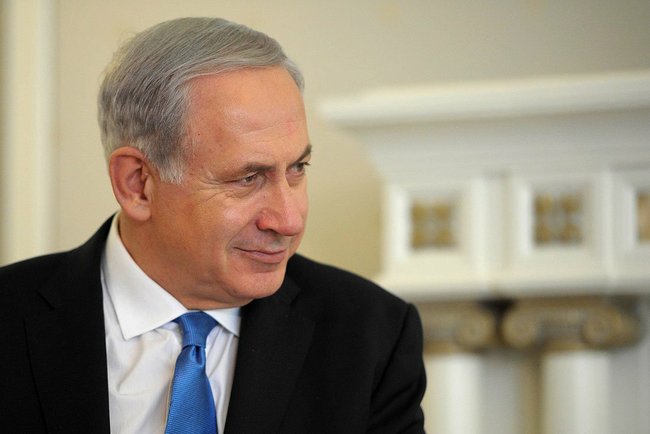
Progressives tell Center for American Progress re #Netanyahu visit: "You've made a mistake.": image via JewishVoiceForPeace @jvplive, 9 November 2015
Benjamin Netanyahu Ignores Roots of Palestinian Violence — and Betrays His Party's Founders: J.J. Goldberg, The Forward, 6 November 2015
At a November 1 top-secret Israeli Cabinet meeting, the tension
between Likud lawmakers and the country’s intelligence chiefs finally
exploded.
The chief of Military Intelligence, Major General Herzl Halevi, had
come to deliver the Israel Defense Forces’ analysis of the terror wave
plaguing Israel for the past month. The main causes, he reported, are
tension over the Temple Mount; anger over the unsolved July 31 murder of
the Dawabsheh family in the West Bank; and rage and despair among
Palestinian youth who see no future and feel they have “nothing to
lose.” Other factors include copycat activity and social-network
influence, plus the declining influence of Palestinian Authority
President Mahmoud Abbas, who is attempting with limited success to halt
the mostly teenage violence.
According to several attendees who spoke to reporters,
the mood at the meeting was tense. Likud up-and-comer Ze’ev Elkin, the
Ukrainian-born immigrant affairs minister, spoke for many present when
he accused Halevi of “blaming Israel” and “acting as a spokesman for the
Palestinians.” Elkin lectured Halevi that he’d ignored the role of
Palestinian incitement. Halevi’s response: “Yes, there is incitement.”
Put differently: Yes, sir, I’ll tell you what you want to hear.
Privately, security officials use barnyard terminology when
discussing the government’s Abbas-incitement charge. Behind the
derision, though, they’re afraid. The nature of Israel’s political
debate has changed. Likud ministers, once the ultimate hard-nosed
realists, now treat intelligence professionals in much the same way that
congressional Republicans treat climate scientists: as alien beings
from an alternate reality.
To see just how dramatically the Likud line has morphed in a few
short decades, consider this passage from an early Zionist writer:
“No indigenous population anywhere at any time has ever been able to
accept the colonization of its country. Every indigenous people, whether
developed or developing, views its country as its national home, in
which it wishes to remain absolute master forever. It will never
willingly grant entry to new masters, nor even to cohabitants or
managerial partners.
“This is true of the Arabs as well.… They may differ from us in
culture, in endurance or determination, but there the difference between
us ends.… They relate to Palestine with an instinctive love and passion
that’s at least equal to what the Aztecs felt toward their Mexico or
the Sioux toward their prairies.…”
Indigenous populations, the author wrote, will resist the newcomers
forcefully unless and until they conclude that the influx cannot be
stopped. At that point, “influence will pass to moderate groups, and
these moderates will come to us with proposals for mutual concessions,
and negotiations can then begin in earnest over practical questions.…”
The words are those of Vladimir Ze’ev Jabotinsky, founder of the
right-wing Zionist Revisionist movement, forerunner of today’s Likud.
They’re from his seminal essay, "The Iron Wall,"
written in 1923 -- six years after Great Britain issued the Balfour
Declaration, calling for a Jewish national home in Palestine, and three
years after the first organized Palestinian revolt against Zionist
immigration.
Jabotinsky argued that the Palestinian violence of 1920–21 was
neither banditry nor anti-Semitism nor an Arab misunderstanding of
Zionist intentions, as many Zionists maintained, but rather natural
resistance by one nation fearing another nation taking over its country.
Accordingly, he wrote, it was pointless to try negotiating or buying
off Palestinian leaders. Rather, Zionism should dig in behind a
metaphorical “iron wall” until the Palestinians accepted the inevitable.
Jabotinsky
was reviled in his day as a racist and a warmonger by the mainstream
Zionist leadership under Chaim Weizmann and later David Ben-Gurion. The
“iron wall” thesis was a key point of disagreement, but not the only
one. Most notably, Jabotinsky insisted the Jewish state must encompass
all of historic Palestine, including what became Jordan. But on the
Palestinian conflict he proved prophetic. He became a political pariah,
but his iron wall thesis became a staple of Israeli defense doctrine.
That is, until 1993, when the Palestine Liberation Organization
formally agreed in Oslo to recognize Israel and negotiate those “mutual
concessions” that Jabotinsky anticipated. To the Israeli military, an
IDF deputy chief of staff once told me, the Oslo Accords were the
Palestinians’ “surrender document.” The next step was supposed to be
negotiating the terms.
That year, 1993, was a watershed for Jabotinsky’s heirs in the Likud.
If Israel’s military and intelligence communities considered the Oslo
Accords a turning point in the Palestinian stance toward Israel, then
the Likud now had to choose between Jabotinsky’s iron wall thesis and
his commitment to the Greater Land of Israel. If the Palestinians were
giving up their claim to exclusive ownership of the land, then it was
time for mutual concessions. If concessions were impossible because
Israeli territorial claims were inviolable, then a way to disregard the
Palestinians’ new stance had to be found.
Most of the Likud chose the Greater Land of Israel. Jabotinsky’s view of Palestinian anti-Zionism as fundamentally about land was abandoned in favor of a metaphysical, almost mystical vision of Palestinian opposition rooted in timeless, immutable hatred of Jews.
As the Likud has morphed from realism to metaphysics, traditional
Jabotinskyites like Dan Meridor and Reuven Rivlin have been marginalized
or forced out. A growing proportion of the party’s younger generation
consists of religious nationalists who don’t hide the mystical roots of
their vision. And, as the retooled Likud has become entrenched in power,
relations with the security services -- the IDF, the Shin Bet and the
Mossad -- have grown steadily more strained.
The
new Likud version of reality has been evolving slowly over the
decades since Oslo. In the past few weeks, with the terror wave as a
backdrop, Prime Minister Benjamin Netanyahu has been rolling it out,
piece by piece, and it’s beginning to emerge as a coherent whole: Nazi
roots of Palestinian nationalism; violence as a product of incitement
from above rather than conditions on the ground; the need for full
Israeli control of “all the territories for the foreseeable future,”
despite the threat of binationalism; and finally, the October 26
announcement, at a stormy session of the Knesset foreign affairs and
defense committee that Israelis “will forever live by the sword.”
Zionism, which first arose to end the Jews’ international pariah status, now promises to trap them there forever.
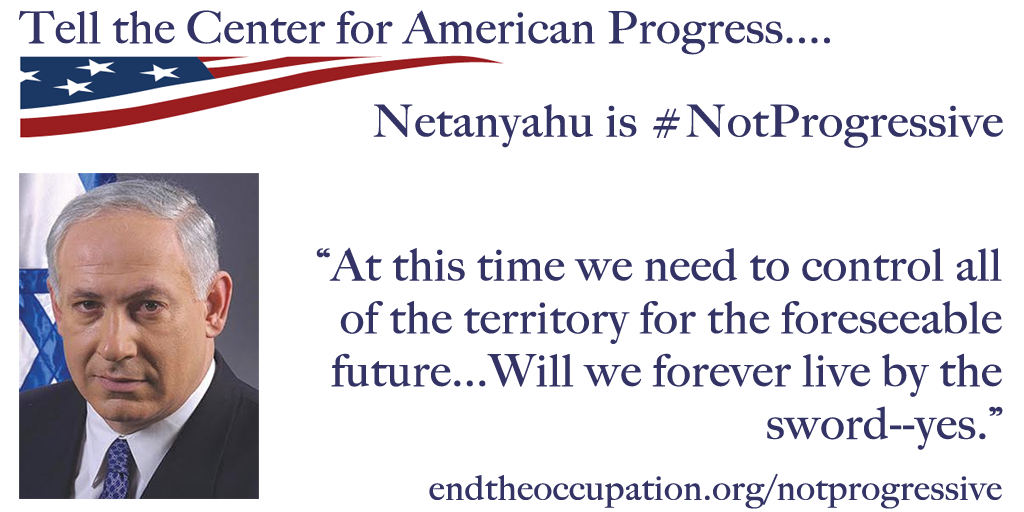

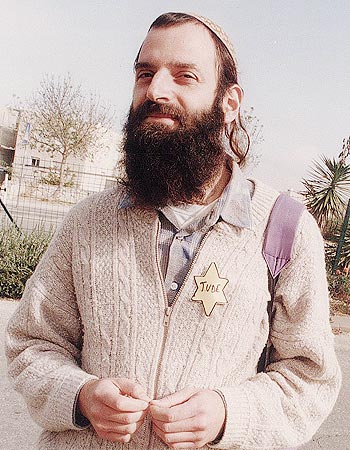

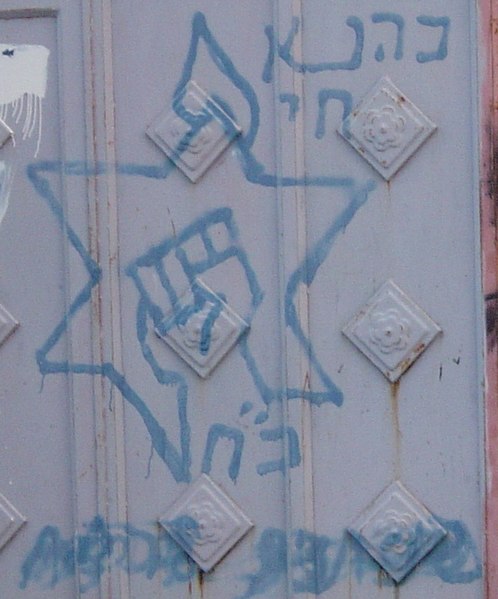
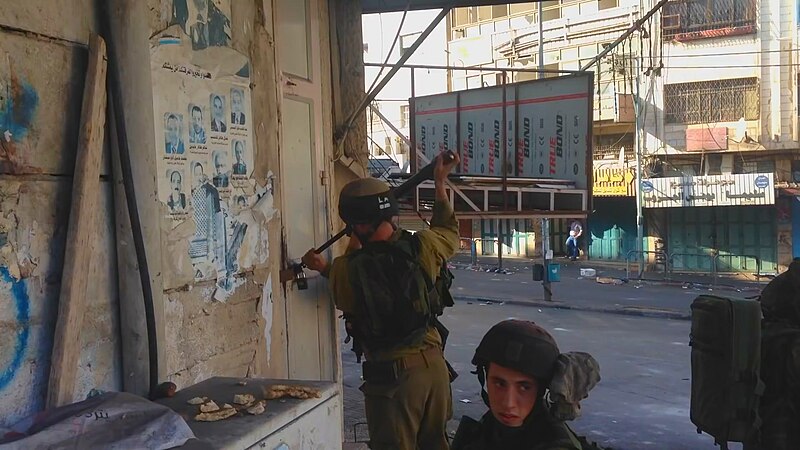











4 comments:
"Settlers" Tour of Hate through Occupied Hebron: An appraisal by Hashem, 18 January 2010 (Part1)
Martyr Hashem al-Azzeh talks about the hardships of living near a settlement
20 October 2014: Hashem Azzeh successfully picked his olives for the first time in fourteen years: today in al-Khalil (Hebron) Hashem Azzeh, a Palestinian man living in the Tel Rumeida neighbourhood (directly opposite an illegal settlement) was able to successfully harvest his olives, on his land, for the first time in 14 years. Hashem and his family live in H2 under full Israeli civil and military control right next to the Tel Rumeida settlement. Every year for the past 14 years Hashem has applied for a permit from Israeli authorities to harvest his own olive trees but he has been either denied or had his olives stolen by Israeli settlers from a local settlement. This year Hashem got one day to harvest six trees on the 20th of October. As Hashem, his brother and internationals harvested the olives, two settlers from the Tel Rumeida settlement, located next to Hashems house came and tried to convince the Israeli police and army present that Hashem´s land belonged to them and that he should not be picking olives on “their land”. Despite the attempts to prevent Hashem from picking on his land, the group succeeded in harvesting all of Hashem´s olives in that area.
Bob Dylan, live in Antwerp 23 October 2011: Love Sick . Not Dark Yet (for @3:26: "I've been to London / and I've been to gay Paree")
Both settlers and soldiers stand about with assault rifles, nothing to separate them. No one should make any mistake, these people aren't just right wing loons, every assault on schoolchildren, the destruction of olive groves, the expropriation of property, all forwards the realisation of Bibi's sour, official dreams.
I hadn't read Mario Vargas Llosa's observations before. My father has visited the occupied territories and has come across such incredulity over here.
"When I told Israeli friends this, some looked at me with incredulity and I saw they suspected I exaggerated or lied, as novelists often do. "
u know I revere the poetry of TC but this is part of the job MVL does on the credibility of the novel as a genre. MVL has lied through his teeth to cover up violent government repression, especially in the early 80s. I've been told he's a joke among young Peruvian writers. But if anyone thinks he's a liar, it's because of the novel as a genre. Yes it's fiction but I'm talking about the writing that's supposed to be non-fiction. He was ok at ripping off Camus but his ripping off Arguedas and Marquez doesn't help digest the cuy.
WB.
Thank you for making a necessary point my hosting courtesy (i.e. pretense of politeness) prevented my making here yesterday. The lines of demarcation between military, police, armed militia ("security"), self-appointed Dodge City vigilante aka settler, and "ordinary" passively-approving citizen-subscriber with license to kill, have now dwindled in Israel to a series of barely noticeable brownish-red telltale smudges, repeatedly overlooked by Shin Bet forensics.
Yes, re the forever unhappy Beebster, absolutely, in the layering of the hell which is Israel, it's a trickle-down arrangement, the evil dripping always down from top to bottom, connected up with a kind of gravity-defying hydroponic recirculation system that permanently cycles the bad blood back up through the downspout, one might say. (I believe it's the raw waste product of the latter that they employ to spray from large armoured vehicles onto demonstrators around the West Bank settlements every Friday.)
Ian,
Were the issue in this post to have been the literary career and political trajectory of Llosa, which, as I take it, describes a broad arc moving roughly over the several decades from left toward centre, as tends to happen with the projects of those who achieve global literary success (including, for example, those two prominent living American poets on whom you have posted lately at your site and elsewhere, both once considered tres avant, both, as surely you must know, now hirelings of corporate-fascist war-state institutions) -- we might best consider this writing of his in that context.
The contextual aspect that really figures here, however, must lie in the fact that this world writer known to be openly sympathetic to Israel, travelling as the guest and under the protection of the Israeli government, in company, if I remember correctly, with his daughter and her Israeli fiancé -- one imagines the circumstances of the Hebron tour afforded by their hosts to Llosa and his party to have been severely constrained and closely controlled, as with the tight herding by heavily armed and vigilant IDF minders of the Saturday morning settler gawker-tours through what's left of the old city, seen in the photos here -- chose to say what he did about what he had seen.
By no stretch could his remarks have been moulded even by an extensive army of trolls unto useful hasbara.
Keeping in mind nobody made him do it. Nobody forced him to compose in a few sentences a picture of the tragedy of Hebron far more compelling and disturbing (and accurate! -- just look at the photos, taken by astonished visitors of many nations and persuasions) than anything that could have been contributed by a witness who approached the situation with subversive intent. In fact the reverse was the case. His intent, and expectation, was to be discovering, and sharing in, something joyous, promising, rich, fresh and new. Instead -- shock, revulsion, horror.
The point of the post is to bear witness to the exacerbated conditions of life under an apartheid regime maintained through the force of terror on the part of a brutal occupying army on behalf of a handful of incentivized instant-nationals from Brooklyn. Oy, talk about ripping off.
Post a Comment